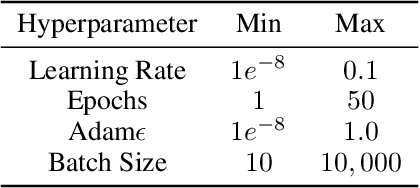Max Zvyagin
CrossedWires: A Dataset of Syntactically Equivalent but Semantically Disparate Deep Learning Models
Aug 29, 2021



Abstract:The training of neural networks using different deep learning frameworks may lead to drastically differing accuracy levels despite the use of the same neural network architecture and identical training hyperparameters such as learning rate and choice of optimization algorithms. Currently, our ability to build standardized deep learning models is limited by the availability of a suite of neural network and corresponding training hyperparameter benchmarks that expose differences between existing deep learning frameworks. In this paper, we present a living dataset of models and hyperparameters, called CrossedWires, that exposes semantic differences between two popular deep learning frameworks: PyTorch and Tensorflow. The CrossedWires dataset currently consists of models trained on CIFAR10 images using three different computer vision architectures: VGG16, ResNet50 and DenseNet121 across a large hyperparameter space. Using hyperparameter optimization, each of the three models was trained on 400 sets of hyperparameters suggested by the HyperSpace search algorithm. The CrossedWires dataset includes PyTorch and Tensforflow models with test accuracies as different as 0.681 on syntactically equivalent models and identical hyperparameter choices. The 340 GB dataset and benchmarks presented here include the performance statistics, training curves, and model weights for all 1200 hyperparameter choices, resulting in 2400 total models. The CrossedWires dataset provides an opportunity to study semantic differences between syntactically equivalent models across popular deep learning frameworks. Further, the insights obtained from this study can enable the development of algorithms and tools that improve reliability and reproducibility of deep learning frameworks. The dataset is freely available at https://github.com/maxzvyagin/crossedwires through a Python API and direct download link.
 Add to Chrome
Add to Chrome Add to Firefox
Add to Firefox Add to Edge
Add to Edge